

The design and features of automobile interiors have undergone significant transformations throughout the years, and no less than in the materials and methods used in upholstering the seats.
That’s the reason why, prior to commencing any upholstery restoration project, it is imperative to ensure that the correct steps documenting each step in the re-upholstery project is being recorded, through the utilisation of tools such as digital photographs or videos, combined to make for effective project management.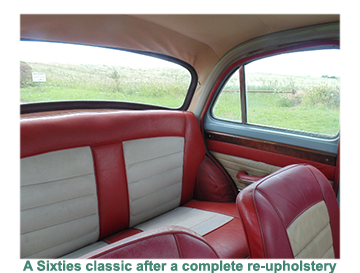 Over the years, vehicle upholstery has undergone significant transformations, in terms of materials used. In the pre-war era, there was a shift from utilitarian low level hides to more luxurious options such as mohair, brocades, and broadcloth. However, during the Fifties and Sixties, when plastics became increasingly popular, the trend swung towards moved towards using durable materials that could withstand wear and tear.
Over the years, vehicle upholstery has undergone significant transformations, in terms of materials used. In the pre-war era, there was a shift from utilitarian low level hides to more luxurious options such as mohair, brocades, and broadcloth. However, during the Fifties and Sixties, when plastics became increasingly popular, the trend swung towards moved towards using durable materials that could withstand wear and tear.
Leather was initially chosen for its exceptional durability, which gradually led to its elevation as a symbol of luxury.
If the vehicle being restored was originally fitted with leather upholstery, it is more likely to be salvageable compared to other materials that are less expensive and less durable, which were primarily intended for the mass market.
In recent times, the availability of advanced steam cleaners has presented a positive aspect. If the upholstery is devoid of any rips, tears, and excessive fading, it is possible to restore it to a satisfactory condition using these powerful steam cleaners. This approach can be significantly more cost-effective compared to the alternative of re-upholstering.
Both options should be thoroughly examined once the vehicle is brought to the workshop.
If a complete re-upholstery is necessary, it would be helpful to provide the upholstery shop with brochures or information about the vehicle when it was first released. This will assist them in understanding the original design and specifications, making the process smoother for both parties involved.
Before any re-upholstery project can seriously get under way, attention should be paid to the springs and fillings within the seats and backs as is highly likely that they will require renewal. Additionally, a thorough check of all the frames should be made, to make sure that they are neither crooked nor broken. If so, they will need to be straightened or repaired. 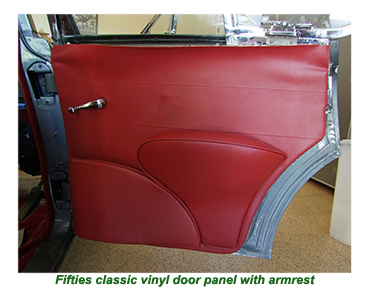 When selecting the fabric for a vehicle's upholstery, it is important to make informed decisions based on factors such as the colour scheme and overall ambience. Considerations should be given to details like edging, stitching, and even the grain pattern, especially if the upholstery will be leather or vinyl.
When selecting the fabric for a vehicle's upholstery, it is important to make informed decisions based on factors such as the colour scheme and overall ambience. Considerations should be given to details like edging, stitching, and even the grain pattern, especially if the upholstery will be leather or vinyl.
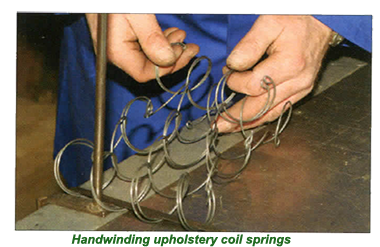 Undertaking a complete or even partial re-upholstery project can be quite challenging, requiring specialist skills and equipment. There are very few amateur car restorers who possess these skills, meaning that the project should be farmed out to a professional, who will do a respectable job although at a considerable cost.
Undertaking a complete or even partial re-upholstery project can be quite challenging, requiring specialist skills and equipment. There are very few amateur car restorers who possess these skills, meaning that the project should be farmed out to a professional, who will do a respectable job although at a considerable cost.
Once the upholstery has been restored to its original condition, the restorer will only need to focus on replacing the car's headlining and door panels.
Replacing door panels should be a more manageable task, although still requiring certain levels of confidence and skill. Many restorers prefer to pass on all aspects of upholstery to professionals, assuring themselves that the overall package will be pleasant to the eye and play a major part in restoring the vehicle’s interior to its original splendour.
![]()
While taking on a full or even partial re-upholstery will be too much for all but the super talented, replacing the head linings and door panels is a much more straightforward operation, although still not for the faint-hearted.
With the upholstery back to their best, all that will remain for the restorer is to renew the car's headlining and door panels.
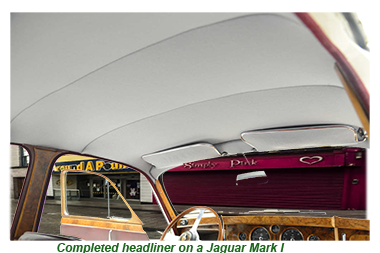 Updating door panels is one of the less challenging car and upholstery renewal projects on the list.
Updating door panels is one of the less challenging car and upholstery renewal projects on the list.
When restoring a classic car, there is a very wide variety of critical issues to be addressed making it common for the headliner to placed lower on the list of priorities and sometimes even be overlooked.
This is a pity as the headliner, typically positioned in the background, plays a crucial role in enhancing the overall interior atmosphere by emitting a radiant glow from above.
When evaluating a classic car for restoration, it is important to consider the potential for damage or discoloration of the headliner, which may require repair or replacement.
In certain instances, the condition of the headlining in a restoration vehicle can vary depending on how it was maintained by its previous owners.
It is possible that the headlining is merely dirty, but it is more likely to be discoloured due to a significant accumulation of nicotine.
This is because drivers and passengers in the Fifties and Sixties tended to be heavier smokers compared to the present day.
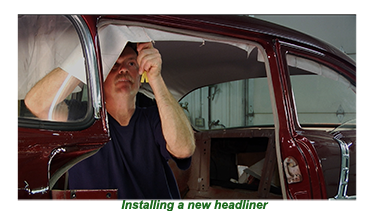 If the cloth is in good condition, it is possible to restore an original headliner without the need to replace it, even if it is stained with nicotine,
If the cloth is in good condition, it is possible to restore an original headliner without the need to replace it, even if it is stained with nicotine,
All that is needed is considerable patience, lots of elbow grease and enough high-quality carpet cleaner.
In the UK and Western Europe, there is network of companies, both large and small, that specialise in classic car upholstery. These companies offer a wide range of specialised services at fair prices.
 These companies typically offer a comprehensive turnkey service and are usually willing to offer guidance on selecting the most suitable materials for the specific job.
These companies typically offer a comprehensive turnkey service and are usually willing to offer guidance on selecting the most suitable materials for the specific job.
Regardless of the approach chosen, the outcome is expected to be impressive and serve as a fitting conclusion to the entire restoration project.
Take me back to the home page.
cu2



